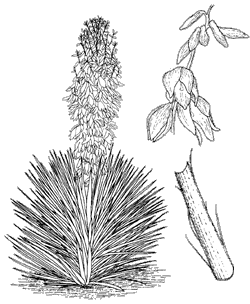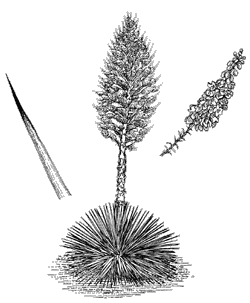Genus Yucca
English names: yucca, Spanish bayonet
Spanish name: palmilla
Yuccas are usually easy to distinguish from agaves even when out of flower. Like all members of the family, they bear leaves in rosettes. But yucca foliage is only semisucculent or nonsucculent and the leaves are usually straight; many species grow trunks. When in bloom, all are easily recognized by their large, white, fleshy, bell-shaped flowers. Unlike most agaves, most yuccas are polycarpic (blooming more than once).
Range
Like agaves, most yucca species occur in semiarid habitats above the desert. Habitats range from the northern Great Plains through woodlands and the dry tropics of Mexico. One species occurs in the southeastern U.S. and the West Indies. About 10 species occur in the Sonoran Desert region.
Ecology
Yucca pollination ecology is an example of a tight symbiosis called a mutualism. (Symbiosis refers to a close association between two species in that at least one benefits from the association. Mutualism is a symbiotic relationship in which each species depends on the other for survival.) With only one exception, yucca reproduction depends on moths (genera Parategiticula, Tegiticula) which deliberately cross-pollinate the flowers. (Yucca aloifolia of the southeastern U.S. is pollinated by bees.) The blossoms need pollen from a different plant in order to produce seed, and it must be packed into a deep receptacle on the stigma, an event that could not occur by chance visitation. The moth is equally dependent on the yucca. It lays eggs on each pollinated ovary, and the hatched larvae eat some of the developing seeds. Biologists have only recently determined that almost every species of yucca has its own species of yucca moth; some yuccas have two moth species. Such a tight mutualism has risks for both partners. Emergence of adult moths must coincide with yucca flowering for the reproductive needs of both species to be met. However, the synchronization of moth emergence with flowering is frequently poor and seed set and moth reproduction in such years are low. Furthermore, yucca populations may flower sparsely or not at all in dry years. Yuccas don’t have to set seed every year because they flower many times in their long lives. The yucca moths employ a survival strategy analagous to that of desert annual plants. The full-grown larvae exit the ripening yucca fruit and burrow into the ground, where they enter a deep dormancy (diapause). Like the seeds of many annuals, only some of the larvae will metamorphose and emerge as moths in the following flowering season. The rest remain in diapause for two or more years.
Ethnobotany
Yucca flowers and fruits are edible fresh or dried. Chemicals in the roots of some species are used to make soap. (The Spanish name amole is applied to a number of unrelated plant species from which soap is made.) The roots of Mohave yucca (Y. schidigera) were used to provide the foaming agent in root beer, and the stems are still (over-) harvested to produce livestock deodorant.
Yucca arizonica (formerly Yucca baccata spp. arizonica)
English names: blue yucca, Spanish bayonet, Thornber yucca
Spanish names: dátil (date), palma criolla (creole or native palm)
Description
A variable semisucculent species, this yucca usually occurs as dense clusters of stems to 8 feet (2.5 m) tall, tipped with rigid bluish to yellowish leaves. The lower half of the wide inflorescence is typically concealed within the leaves.
 |
Range
From the Sonoran Desert into oak-pine woodland, southern Arizona to central Sonora.
Comments
It was formerly considered a subspecies of banana yucca (Y. baccata), a more widespread, usually stemless or recumbent species. Its roots are used for red fiber in Tohono O’odham baskets.
Yucca elata
English names: soaptree yucca, soapweed
Spanish names: palmilla, palmito, soyate, cortadillo
Description
The soaptree yucca has a simple or branched trunk up to 23 feet (7 m) tall. The numerous 2-foot (0.6 m) long, thin, flexible leaves are clustered at the ends of the stems, making the plant appear somewhat like a palm. Flowers are creamy white, borne in a great cloud on the upper half of a stalk up to 10 feet (3 m) tall, usually in May and June.
 |
Range
Soaptrees grow mainly in desert grassland from central Arizona to west Texas and northern Mexico. The range extends into the upper margin of Arizona Upland.
Comments
The leaves yield the major basketry fiber for the Tohono O’odham, who know how to harvest the tender new leaves in a way that promotes branching instead of killing the plant. The English common name refers to another of its uses.
Hesperoyucca whipplei (formerly Yucca whipplei)
English names: Spanish bayonet, our Lord’s candle, chaparral yucca
Spanish names: sotolillo, lechuguilla, quiote
 |
Description
The bluish-green rosette 3 to 6 feet (1-2 m) in diameter consists of about a hundred long, narrow, and dangerously rigid, sharp-tipped leaves. Rosettes are single to multiple in different subspecies. The inflorescence rises well above the leaves, usually about 8 feet (2.5 m) tall in the desert forms, bearing dense masses of creamy-white flowers (tinged with purple in some populations). The flowering rosette dies, so the nonclustering subspecies are monocarpic.
Range
This plant is primarily a chaparral species of the Californias, with a few desert populations in the Lower Colorado River Valley and gulf side of the Baja California peninsula. The desert form is usually about 3 feet (1 m) in diameter and nonclustering.
Comments
This species was recently removed from the genus Yucca because it was determined to be only distantly related. Its pollinating moth is also distinct.










